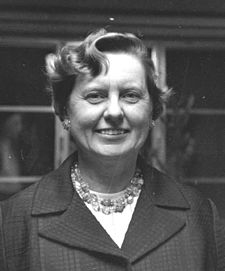- Margaret Oakley Dayhoff
-
Margaret Oakley Dayhoff 
Born March 11, 1925
Philadelphia, PennsylvaniaDied February 5, 1983 (aged 57)
Silver Spring, MarylandNationality United States Fields Bioinformatics Institutions Columbia University Known for Substitution matrices
one-letter codeInfluences George Kimball Dr. Margaret Belle (Oakley) Dayhoff (March 11, 1925 – February 5, 1983) was an American physical chemist and a pioneer in the field of bioinformatics. Dayhoff was a professor at Georgetown University Medical Center and a noted research biochemist at the National Biomedical Research Foundation where she pioneered the application of mathematics and computational methods to the field of biochemistry. She dedicated her career to applying the evolving computational technologies to support advances in biology and medicine, most notably the creation of protein and nucleic acid databases and tools to interrogate the databases. Her PhD degree was from Columbia University in the Department of Chemistry, where she devised computational methods to calculate molecular resonance energies of several organic compounds. She did postdoctoral studies at the Rockefeller Institute (now Rockefeller University) and the University of Maryland, and joined the newly established National Biomedical Research Foundation in 1959. She was the first woman to hold office in the Biophysical Society, first as Secretary and eventually President. She originated one of the first substitution matrices, Point accepted mutations (PAM). The one-letter code used for amino acids was developed by her, reflecting an attempt to reduce the size of the data files used to describe amino acid sequences in an era of punch-card computing.
Contents
Early life
Dayhoff was born an only child in Philadelphia, but moved to New York City as a child. Her academic promise was evident from the outset; she was valedictorian (class of 1942) at Bayside High School, Bayside, New York and from there received a scholarship to Washington Square College of New York University, graduating magna cum laude in mathematics in 1945.
Research
From there, Dayhoff undertook a Ph.D. in quantum chemistry, under George Kimball, in the Columbia University Department of Chemistry. In her graduate thesis, Dayhoff had pioneered the use of computer capabilities — i.e., mass-data processing — to theoretical chemistry; specifically, she applied punch card machines to calculate the resonance energies of several polycyclic organic molecules.
After completing her Ph.D, Dayhoff studied electrochemistry at the Rockefeller Institute from 1948 to 1951. In 1952, she moved to Maryland with her family and later received a research fellowship from the University of Maryland (1957–1959), working on a model of chemical bonding with Ellis Lippincott. She taught physiology and biophysics for 13 years, while becoming affiliated with the National Biomedical Research Foundation, a Fellow of the American Association for the Advancement of Science, a councillor of the International Society for the Study of the Origins of Life (1980) and acting on the editorial boards of DNA, Journal of Molecular Evolution and Computers in Biology and Medicine.
Frederic Sanger's determination of the first complete amino acid sequence of a protein (insulin) in 1955, led a number of researchers to sequence various proteins from different species. In the early 1960s, a theory was developed that small differences between homologous protein sequences (sequences with a high likelihood of common ancestry) could indicate the process and rate of evolutionary change on the molecular level. The notion that such molecular analysis could help scientists decode evolutionary patterns in organisms was formalized in the published papers of Emile Zuckerkandl and Linus Pauling in 1962 and 1965. Dayhoff worked side by side with Lippincott and Carl Sagan on thermodynamic models of cosmo-chemical systems, including prebiological planetary atmospheres.
Dayhoff went on to pioneer the development of programmable computer methods for use in comparing protein sequences and deriving their evolutionary histories (in other words, discerning homologies) from their sequence alignments. Though this was before the days of massive outputs of sequence information by automated and other methods, Margaret Dayhoff anticipated the potential of computers to the current theories of Zuckerkandl & Pauling and the method which Sanger had engineered.
With Richard Eck, she published the first reconstruction of a phylogeny (evolutionary tree) by computers from molecular sequences, using a maximum parsimony method. She also formulated the first probability model of protein evolution, the PAM model, in 1966.
She initiated the collection of protein sequences in the Atlas of Protein Sequence and Structure, a book collecting all known protein sequences that she published in 1965. It was subsequently republished in several editions. This led to the Protein Information Resource database of protein sequences, which was developed by her group. It and the parallel effort by Walter Goad which led to the GenBank database of nucleic acid sequences are the twin origins of the modern databases of molecular sequences. The Atlas was organized by gene families, and she is regarded as a pioneer in their recognition. Her approach to proteins was always determinedly evolutionary. Margaret Oakley Dayoff died of a heart attack at the age of 57.
David Lipman has called Dayhoff the mother and father of bioinformatics. Lipman, who is director of the National Center for Biotechnology Information is also the scientist who spearheaded the collaborative project that produced BLAST. His ongoing work in developing better computational methods for molecular biology attests to his inheritance of Dayhoff’s legacy.
References
- Hunt, Lois T. (1983). "Margaret O. Dayhoff 1925-1983". DNA (Mary Ann Liebert, Inc.) 2 (2): 97–98. doi:10.1089/dna.1983.2.97. ISSN 0198-0238. PMID 6347589. http://www.liebertonline.com/doi/pdfplus/10.1089/dna.1983.2.97.
External links
- Dr. Margaret Oakley Dayhoff — Pioneer in Bioinformatics
- Picture of Margaret Oakley Dayhoff, c. 1980. Owned by her daughter Ruth E. Dayhoff, M.D. Made available by the National Library of Medicine.
Categories:- 1925 births
- 1983 deaths
- Bioinformaticians
- American biochemists
- American biologists
- Women biologists
Wikimedia Foundation. 2010.
